Emotional Regulation: 6 Key Skills to Regulate Emotions
 Emotions signal threats and rewards. Much like a compass that guides us in the right direction, emotions have the power to guide us to the right actions.
Emotions signal threats and rewards. Much like a compass that guides us in the right direction, emotions have the power to guide us to the right actions.
For example, when a child commits a mistake, they might get scared and lie to their parents about it, or avoid confronting them for fear of punishment.
Their parents may eventually discover what they did and the child, in all probability will end up facing the same consequences that they were trying to avoid. In this instance, listening and responding to the ‘fear’ emotion proved futile to the child.
However, the same emotion (fear) would have proven helpful for someone being chased by a wild animal in the forest. In that situation, running to avoid confronting the savage beast would have been the correct decision.
It is therefore crucial to judge when to trust emotional triggers and act on them, and when not to; in other words, it is essential for us to understand how to regulate or control our emotions so we could use them optimally.
In this article, we will discuss the psychology of emotional regulation – what it means, how we can cultivate it, and what methods we can choose to implement emotional management in real life.
Before you read on, we thought you might like to download our three Emotional Intelligence Exercises for free. These science-based exercises will not only enhance your ability to understand and regulate your emotions but will also give you the tools to foster the emotional intelligence of your clients, students or employees.
This Article Contains:
- What is Emotional Regulation? A Definition
- 6 Most Useful Emotional Regulation Skills for Adults
- Science-Based Emotion Regulation Strategies
- What is Emotional Regulation Disorder?
- 5 Tips for Fostering Emotional Regulation in Children
- What is DBT and How Does it Relate?
- 4 Emotional Regulation Activities & Exercises
- Useful Therapy Modalities
- Techniques for Working with Autism
- 3 Worksheets to Implement the Theory
- Examples of Emotional Self-Regulation
- Games for Group Therapy Settings
- Best Books on Emotional Regulation
- A Take-Home Message
- References
What is Emotional Regulation? A Definition
“Emotional regulation refers to the process by which individuals influence which emotions they have, when they have them, and how they experience and express their feelings. Emotional regulation can be automatic or controlled, conscious or unconscious, and may have effects at one or more points in the emotion producing process.”
(Gross, 1998, p. 275).
The definition of emotional regulation encompasses both positive and negative feelings, along with how we can strengthen them, use them, and control them.
Emotional regulation involves three components:
- Initiating actions triggered by emotions.
- Inhibiting actions triggered by emotions.
- Modulating responses triggered by emotions.
Ideally, the third component is the best way to make the most of the regulatory processes.
Every day, we face hundreds of emotion-provoking stimuli, and most of them require some action or response from our end. It is only natural for the mind to get hooked into some negative contemplation or unmindfully ignore emotions after getting bombarded with so many stimuli every day (Davidson, 1998).
Emotional regulation acts as a modifier; it helps us filter the most important pieces of information and motivates us to attend to it in a way that wouldn’t evoke stress or fear.
Studies on emotional regulation indicate that there is a significant positive correlation between emotion regulation and depression management. People with lower levels of anxiety show higher emotional control and social-emotional intelligence.
Research indicates that emotions are adaptive responses that have a deep-rooted basis in evolutionary biology (Levenson, 1999). The way we feel and interpret them affects how we think, how we decide, and how we coordinate our actions in day-to-day lives.
For example, a person who has poor emotion regulation strategies is more likely to fall prey to mood polarities; their actions and behavioral patterns would always be at the mercy of their emotions.
Quite the contrary, a well-regulated person, will have a better balance and judgment of their feelings and actions. Emotional regulation allows us to carefully judge which affective outcomes to embrace and which ones to avoid (Wegner, Erber, & Zanakos, 1993).
When we confront a provoking stimulus, the natural reaction of the brain is to activate the amygdala, a brain site that regulates the fight-or-flight responses (Lee, 2018; Van der Kolk, 1994). Emotional regulation processes allow us to buy time before we act on the fight or flight triggers.
Kris Lee, a Professor and the author of the book Mentalligence: A New Psychology of Thinking–Learn What It Takes to be More Agile, Mindful, and Connected in Today’s World says that with emotional regulation, we can allow the initial upsurge of emotions to settle down and zoom out of the situation before reacting to it.
The increased time gap between stimulus and response restores the mental faculties that involve rational thinking and reasoning. As a result, we can save ourselves from sudden emotional breakdowns or burnout.
6 Most Useful Emotional Regulation Skills for Adults
Self-regulation is all about pausing between feeling and reactions – it encourages us to slow down for a bit and act after objectively evaluating a situation. For example, a student who yells at others and hits their friends for petty reasons surely has less emotional control than a child who, before hitting or yelling, tells the teacher about their problems.
Another huge aspect of emotional regulation is value engagement. When we react impulsively without paying much attention to what is going on inside, we might often deviate from our core values and act in a way that is opposite to them. With proper regulation and self-control, we gain the power to stay calm under pressure and prevent ourselves from acting against our core values and ethics.
Here are some skills that can help in cultivating emotional regulation and sustaining it during challenging times in life.
1. Self-awareness
Noticing what we feel and naming it is a great step toward emotional regulation. For example, when you feel bad, ask yourself – Am I feeling sad, hopeless, ashamed, or anxious?
Give yourself some options and explore your feelings. Try to name the specific emotions that you can feel intensely within yourself at that very moment, and write it down if you want. You need not act or judge the cause and effect of your emotions at this stage; all you need is complete awareness of each feeling that is controlling your mind ‘right now.’
2. Mindful awareness
In addition to gaining thought awareness, mindfulness lets us explore and identify all aspects of the external world, including our body. Simple mindful exercises such as breath control or sensory relaxation can calm the storm inside and guide our actions in the right way.
3. Cognitive reappraisal
Cognitive reappraisal includes altering the way we think. It is an essential component of psychotherapies like CBT, DBT, and Anger Management, and calls for greater acceptance and flexibility.
Cognitive reappraisal skills may include practices such as thought replacement or situational role reversals, where we try to look into a stressful situation from a whole new perspective.
For example, we can replace thoughts like ‘My boss hates me’, ‘I am no longer needed here’, etc. with alternatives such as, ‘My boss is upset at this moment, I am sure I can make up for this’, or ‘I know I am hard working and honest, let me give it another try’, etc.. By doing so, we gain a broader and better perception of our problems and react to them with more positivity.
4. Adaptability
Emotional dysregulation lowers our adaptability to life changes. We become more prone to distractions and fail our coping mechanisms, which is why we often start resisting changes. A great exercise to build adaptability is objective evaluation.
For example, when you feel bogged down by stressful emotions that you want to avoid, and you might end up destructively reacting to them, take a moment to think what if your best friend was experiencing the same thing? What would you have suggested they do under these circumstances? Write your answers if you want to and try to think if you are following the same steps for yourself!
5. Self-compassion
Setting aside some time for ourselves every day is a great way to build emotional regulation skills. Reminding ourselves of our talents and virtues, and letting our minds land on a flexible space can immensely change the way we feel and react to our emotions.
Some simple self-compassion hacks involve:
- Daily positive self-affirmations
- Relaxation and breath control
- Compassion meditation
- Regular self-care
- Gratitude journaling
6. Emotional support
Psychologists believe that we all have the innate capacity to build a robust emotional repertoire and save our mental energy from getting invested in negativity. We can seek emotional support within ourselves by practicing mindful self-awareness or can seek help outside by engaging in positive communication with others.
It is okay to see a therapist or professional when our inner coping fails; the sole focus is to create a positive emotional shield that can channelize our emotions to bring out the best in us.
You aren’t at the mercy of your emotions — your brain creates them – Lisa Feldman Barrett
Science-Based Emotion Regulation Strategies
Literary resources on emotional regulation have provided a myriad of solutions for emotional dysregulation. While all the self-regulation strategies are undoubtedly useful and practical, the problem arises when we have to choose the best plan for us (Gross, 2015; Ochsner, Silvers, & Buhle, 2012).
Most scientific research on emotional regulation focus on either a particular age group that could benefit from the strategy, or a specific situation in which it works the best (Webb, Miles, & Sheeran, 2012). Little is said about the scientific methods that we could use for taming our feelings at all times.
Recent studies, however, have shed some light in this regard. Researchers nowadays agree that emotion regulation should not be constrained to a time frame or a group of individuals under a specific circumstance, and have proposed a few scientific strategies that could guide us at all times (Aldao, 2013; Gross, 2015).
1. Reappraisal
Reappraisal or cognitive reappraisal ensures long-term wellbeing and offers a permanent solution to emotional distress. Through re-evaluation, we do not aim to suppress or eliminate the negative emotions that cause pain forcefully, instead, we look for better ways of dealing with it (Davis, Senghas, Brandt, & Ochsner, 2010).
In addition to finding appropriate and positive substitutes of the problems, cognitive reappraisal also shifts our focus from the distress and reduces the impact of the negative emotion for a while (Troy, Shallcross, & Mauss, 2013).
2. Self-soothing
Self-soothing, in any form, can reduce the toxic effects of anger, sadness, and agony that negative experiences bring (Heiy & Cheavens, 2014). Scientists believe that self-soothing, as opposed to self-confrontation, guarantees better and quicker answers when it comes to managing thoughts and emotions.
We can practice several variations of self-soothing exercises, including:
- Self-compassion and loving-kindness meditation.
- Music meditation, where we set aside some minutes to listen to music and unwind ourselves with the relaxing sound.
- Reminiscence therapy, which works great for resolving emotional conflicts involving other people. The practice involves merely sitting and trying to recollect all the good memories we have once had with the person we are now struggling with.
- Breathing exercises, including breath control, breath counting, and simple breath relaxation.
- Simple self-care such as a hot bath, a relaxing massage, cooking for yourself, etc.
3. Attentional control
Attentional control starts with reappraisal. It aims to divert our attention away from the negative emotion and allows us to look at it from a rewarding perspective.
For example, we can overpower the irresistible anger and shame that follows an insult or abuse from someone, by thinking of it as a lesson that taught you to avoid building connections with rude people.
By focusing more on what you learned from the conflict, you not only save yourself from the severe stress and agony, but you also gain a perspective of how you can avoid such interpersonal disputes later. As a result, you are successful in modulating your responses to the negative encounter and restoring your mental peace altogether (Gross & John, 2003).
What is Emotional Regulation Disorder?
As the name indicates, emotional regulation disorder is a condition of impaired or dysfunctional ability to regulate and manage emotions optimally. Emotional Dysregulation (ED) is a term mental health specialists use for emotional responses that are weakly managed and deviate from the accepted range of positive reactions.
The emotional regulation disorder is often manifested by symptoms such as:
- Sudden and unexplained anger outbursts that get displaced to someone who did not cause any harm. May include passive-aggressive patterns of behavior.
- Somatoform symptoms such as chronic pain and illness not caused by any medical condition and remain unexplained by medical professionals.
- Self-destruction or self-harming behavior, including extreme thoughts of suicide.
- Difficulty in building and maintaining healthy social relationships in personal and professional fields.
- Attentional dysregulation, including the inability to focus on meaningful work because the mind is too occupied with negative thoughts and emotions.
- Hypersensitivity and poor self-control.
The worst part of Emotion Regulation Disorder is that it mostly comes in association with other mental health issues such as depression, stress, or extreme mood polarities, and therefore, management requires an overall intervention plan for addressing all the associated problems.
The most common intervention psychologists use for managing EDD is Dialectical Behavior Therapy (DBT), in combination with some cognitive strategies and emotional support adjuncts.
The prognosis of Emotional Regulation Disorder is relatively good, considering the number of practical interventions that we could use. The best results are, however, seen when the person chooses to take charge of it soon and participates in a long-term treatment plan.
5 Tips for Fostering Emotional Regulation in Children
Emotional regulation is an absolute necessity for academic, social, and moral development in children. Parents often find it overwhelming to find the right way to teach emotional regulation to their children and help them deal with the inevitable stressors of everyday life.
Emotional perception and management are never the same for two people, which is why successfully training someone to regulate their emotions can be a difficult task. However, psychologists over the years have come up with some great solutions to this problem.
Here are some hacks that parents and carers can use to cultivate emotional regulation in youngsters (Toub, Rajan, Golinkoff, & Hirsh-Pasek, 2016).
1. Model the right behavior
Children learn best through observation. Showing them what to do rather than verbally directing is sure to generate better results. For example, a child grows up with parents who treat each other with respect and resolve their conflicts without being abusive, will learn to be more emotionally balanced and resilient than a child who grows up with aggressive and abusive parents.
It is essential to show children that positivity is the ‘only’ way to deal with stressors, and the best way to do it is by practicing the same ourselves.
2. Delay response time
Encourage the child not to give immediate reactions. Whenever the kid gets angry or is sad, ask them to hold back for a while and react after that. The delay in response time allows the fight-or-flight response to settle down, and in all probability, the child would respond less intensely than they would otherwise have.
3. Work on the child’s emotional vocabulary
Self-expression works great for emotional regulation in children. Often, a child experiences something that they are unable to explain, and the frustration that follows leads to an unpleasant reaction that is not acceptable.
A useful strategy is to create a chart with all the emotions named in it, with examples or face illustrations of how the particular passion makes us feel. Being able to call the feelings they are experiencing makes a child more vigilant and aware of their innermost feelings, and reduces the chances of emotional outbursts.
4. Teach them about actions and consequences
When a child is aware of what their actions might bring to them, they will likely choose their steps carefully. Whether in the classroom or at home, we can engage in meaningful conversations with kids about what is an action and what could be its consequences. For example, teachers and parents could make a chart and list some activities with their potential impacts and ask the child to decide which actions they would choose.
5. Let them detect stress
The goal of fostering emotional regulation in children is to make them self-dependent as a person in the future. There are particular situations, people, or events that create stress in children, for example, going to school away from parents, getting scolded by teachers, or someone taking away their favorite toy.
If we could devote some time to help them identify the little things that bring unpleasant feelings in them, it can go a long way in making them aware of their stressors and provide them the strength to deal with their emotions effectively as they grow up.
What is DBT and How Does it Relate?
Dialectical Behavior Therapy (DBT) is a cognitive and behavior-oriented psychotherapy that relies on active communication to address mental health issues. DBT is especially useful for treating personality disorders like BPD (Borderline Personality Disorder) where individuals lose track of their emotional control mechanisms.
The core principle of DBT is that the arousal levels in different stressful encounters vary from person to person. For example, the way an adolescent would react to their parent’s death would be different from how a 50-year-old person would respond to parental loss, and needless to mention, the consequences of these reactions would hugely differ too (Kleindienst et al., 2011).
Again, a person who is timid and shy would react differently to any abuse from an extravert and friendly person. By considering these individual differences, DBT makes the interventions precise and person-centered.
In its pure form, DBT is:
- Supportive – in the way it helps individuals understand and manage their emotional experiences and reactions.
- Cognitive – because it emphasizes thoughts and acknowledges the fact that our emotions arise from the way we think and interpret the contemplations.
- Mutual – as it requires equal amounts of attention and effort from the client and the therapist. Much like CBT interventions, DBT also relies on collaborative exercises, activities, and homework that help in assessing progress.
The reason why DBT is suitable for dealing with emotional regulation disorder is that it lets individuals learn, acknowledge, and change their faulty thought patterns themselves (Siever & Davis, 1991). DBT doesn’t coerce solutions or rush to diagnosis; it operates on the belief that unless we can internalize the positive emotions and learn to use them ourselves, no therapy can be good enough to make us happier.
DBT skills for emotional management includes:
- Learning and identification of negative and positive emotions.
- Labeling and naming emotions.
- Reducing emotional vulnerability and hypersensitivity.
- Gaining awareness about how we are feeling at the present moment.
- Understanding desirable actions and implementing them in real life situations.
- Enhancing stress management and coping techniques (Bohus et al., 2004; Linehan, Armstrong, Suarez, Allmon, & Heard, 1991).
4 Emotional Regulation Activities & Exercises
Below are four exercises that can be practiced by anyone. Breathing regulation exercises are useful in a variety of settings, and just being mindful of emotions in general can benefit any person.
1. Breathing exercises for emotional regulation
Three main breathing exercises help in modulating emotions:
- Breath Counting – Where we sit calmly for a few seconds and slowly start counting. For example, you can count 5 to inhale and 7 to exhale. The goal of this exercise is to focus on our breathing and follow the counting as we inhale and exhale.
- Breath Shifting – Here we place one hand on our chest and the other hand on our abdomen and notice how they rise and fall with each inhales and exhales. By doing so, we aim to see the difference between the chest and belly movement during breathing, and it helps in regaining focus into our bodies.
- Breath Relaxation – Breath relaxation is the most basic breathing exercise and practically works well for any stress, anxiety, or emotional disorder. The practice is to sit back and take deep breaths with eyes closed, and continue doing so until we can feel the connection between our mind and body, and realize the stress and negativity are fading away with the deep breaths.
2. Exercise for emotional catharsis
The most significant problem of emotional dysregulation disorder is the inability to let go of emotions. Even after realizing the inappropriateness of irrational thoughts, they find it hard to eliminate them from the mind (Singer et al., 2012). Through emotional catharsis, which is a way of venting out the suppressed emotions, we can achieve the mental balance that we often seek.
The practice is simple and involves five easy steps:
- Observing emotions as they are, without trying to change them at the first instance.
- Trying to evaluate the experience and feelings that come with a particular emotion.
- Acknowledging the fact that we are not our emotions. For example, if we are feeling sad, it doesn’t have to mean that we are depressed individuals. Emotions are just a state of mind; they come and go.
- Naming the emotions aloud or writing them the way you feel it.
- Talking about them to a friend, family, or therapist, without being afraid of judgment.
3. Mindfulness for emotions
We know that mindfulness is the art of living in the present moment. Practicing mindfulness helps us gaining awareness of our mind, body, and feelings. It builds a secure connection to the present and allows us to look at our thoughts and feelings from an objective and neutral perspective.
There are two types of mindfulness exercises that help in emotional regulation:
- The ‘Acknowledgment’ Exercises – including careful observation, naming thoughts, and labeling emotions.
- The ‘Implementation’ Exercises – including practices of thinking non-judgmentally, active and empathetic listening, effective communication, and self-expression.
4. Self-awareness techniques
Self-awareness, for the most of it, is a counterpart of mindfulness and is tied in with recognizing one’s own emotions and the ways they affect us.
A great way to manage unhealthy emotions through self-awareness is the thought naming exercise, where we make a list of all the thoughts that are dominating our mind this very moment, the people or circumstances that we think may be causing them, and name the emotions in one or two words.
We can practice this as a daily self-help practice, and make a chart like the one shown below:
| What I am feeling right now | What person/situation caused it | How I responded to the situation/person | What emotion/s did I feel at that point of time? |
|---|---|---|---|
| . | . | . | . |
| . | . | . | . |
| . | . | . | . |
| . | . | . | . |
Useful Therapy Modalities
Which therapy modalities are particularly useful for emotion regulation?
1. Emotional Regulation Therapy (ERT)
Emotion Regulation Therapy is a person-centered approach to dealing with affective regulation. It uses parts of CBT, DBT, Mindfulness, and other humanistic approaches to achieve the following goals:
- Helping individuals identify, acknowledge, and describe their emotions.
- Allowing unconditional self-acceptance that ultimately results in emotional regulation.
- Preventing them from avoiding feelings and choosing actions that impact on their wellbeing.
- Helping them learn better decision-making, constructive critical thinking, and problem-solving skills.
ERT interventions operate on a four-dimensional model, as shown below. Studies have proved that administering ERT strategies to patients increase their chances of recovery from disorders such as GAD, PTSD, and severe depression (Fresco, Mennin, Heimberg, & Ritter, 2013).
2. Cognitive Therapy
Cognitive Therapy interventions used in emotional regulation include:
- Cognitive Distraction – which is an antecedent-focused strategy involving a careful shift of attention from the negative emotion to something pleasant (Gross, 1998). It is a practical approach where clients get positive stimuli from therapists or coaches to focus on when they feel low. Slowly, the individuals get conditioned to shift their attention the moment they catch themselves indulging in toxic emotions (Nolen-Hoeksema, Wisco, & Lyubomirsky, 2008; Sheppes, Scheibe, Suri, & Gross, 2011).
- Cognitive Reappraisal – As we discussed before, cognitive reappraisal is an intervention whose goal is to help us acknowledge the negative emotions at first, and then slowly replace it with other positive emotions that are less provoking.
- Cognitive Labeling – Labeling is a neuro-linguistic process of identifying emotions as they arise. Studies have shown that when we can recognize and literally ‘name’ our feelings and have a complete awareness of the emotional boundaries, there is decreased activity in the amygdala, a part of the brain that regulates emotions (Hariri, Bookheimer, & Mazziotta, 2000; Lieberman et al., 2007).
3. MBCT (Group Therapy)
MBCT or Mindfulness-Based Cognitive Therapy reduces the chances of relapse in people with emotional regulation disorders. It has proven benefits in treating cardiovascular conditions, hormonal deficits, and hypertension that comes with emotional imbalance.
MBCT is usually conducted in group settings, which makes it a preferred option for many people. The process mainly entails in forming a positive relationship with our innermost feelings.
For example, when someone is at the verge of relapsing depression, MBCT teaches them how they can overcome the blues by not trying to change themselves. Through mindfulness and meditation, MBCT reforms the way we feel about ourselves.
Techniques for Working with Autism
Autism Spectrum Disorders (ASD) are a group of neurodevelopmental conditions that interfere with a person’s social, emotional, and executive functioning.
As stated in DSM 5 (Diagnostic and Statistical Manual for Mental Health Disorders), autism causes:
- Impairment in communication and social interaction.
- Repetitive behavioral patterns that may sometimes be aggressive or extreme.
- Poor impulse control and judgment.
- Muscular inflexibility, involuntary movements, and other sensory-motor disturbances.
The typical difficulty that most autistic individuals face is executive dysfunctioning, including impulse control problems, emotional management, self-expression, and anger management.
Psychological regulation strategies specifically created for helping people with ASD primarily focus on separating emotions from the self. It helps autistic individuals understand that they need not act on their feelings; they learn that simply acknowledging emotions can also be a way of responding, without hurting themselves or others.
Another significant aspect that ER strategies deal with is the social and communication deficits autistic people face. There is a 5-point scale that many mental health practitioners and special educators use for helping ASD clients. The scale is created visually to facilitate easy comprehension. The test is systematic and follows a step-by-step approach.
The test starts with the identification of the problem areas, for example, daily routine, self-care, communication, etc.
- After identification, caregivers of the client rate each problem based on how much it affects them on a 5-point scale where 5 indicates the most severe issue, and 1 indicates the least severe problem.
- After listing down and rating the troubles, parents or caregivers come up with a list of the environmental and social factors that they think might be causing the problems.
- Finally, the therapist makes small cards with visual illustrations of each situation that parents earlier labeled as a potential stressor. The cards are presented to the autistic person one by one, and the therapist asks them to express in their way how they feel about it.
- Other ER based strategies for helping ASD includes visual expression, media awareness, creative painting and crafts, and group activities.
3 Worksheets to Implement the Theory
There are three worksheets especially applicable to emotion regulation.
1. The Radical Acceptance Worksheet
Marsha Linehan, a famous American psychologist and the creator of Dialectical Behavior Therapy, adopted the concept of radical acceptance from Buddhist teachings and incorporated it in her works later.
The Radical Acceptance Worksheet is often used in DBT interventions as it helps in enhancing self-awareness and understanding the underlying causes of our emotional struggles. The worksheet consists of seven subjective questions, the answers to which suggest the level of emotional control and indicate possible thinking errors.
The sheet is illustrated below. Each question comes with clear, guided instructions, and there are no right or wrong answers here.
| The Radical Acceptance Worksheet |
|---|
| Question 1 – Describe a stressful situation you encountered. How did the situation occur? How did it affect you? |
| . . . |
| Question 2 – Did you or your behavior lead to the situation stated above? If yes, how? |
| . . . |
| Question 3 – How did others around you contribute to the situation? |
| . . . |
| Question 4 – What control did you have on yourself during that situation? |
| . . . |
| Question 5 – What was your reaction to the situation? Do you think your behavior impacted your emotions? |
| . . . |
| Question 6 – Did your reaction affect others around you? If yes, how? |
| . . . |
| Question 7 – How would you react to similar stressful circumstances in the future? |
| . . . |
2. Emotion Regulation Worksheet
The Emotion Regulation Worksheet is a step-by-step approach to identifying our emotions in a clear and unbiased manner. Adapted from Linehan’s manual for treating Borderline Personality Disorder, this worksheet helps in delving deep into the causes and consequences of an intense affective response.
With simple questions that indicate functionality of the emotion, this self-help manual lets us gauge how powerful our emotions can be. The worksheet is shown below.
Find more information on the emotion regulation questionnaire here.
| Think of a situation in the past that evoked strong emotions in you and answer the following questions: |
|---|
| What led to the situation? |
| . . . |
| How did you interpret the situation? |
| . . . |
| How intense were your emotions (say on a scale of 0-100)? |
| . . . |
| Did your emotion influence others’ actions? If yes, how? |
| . . . |
| Did the emotion influence your actions? If yes, how? |
| . . . |
| Did your emotion influence your judgment? If yes, how? |
| . . . |
3. The PLEASE Worksheet
The Please Worksheet is standard in DBT interventions for emotional management and self-expression.
PLEASE is an anagram using five key concepts:
- Physical health and illness
- Mood changing substances
- Eating habits
- Sleep
- Exercise and Fitness
Through managing these aspects of life, the PLEASE Worksheet fosters emotional management and promotes healthy living. The exercise has questions dedicated to each of the five components, and results reflect how the areas affect our emotions and actions. The worksheet is briefly illustrated below.
Since it is usually a counterpart of therapy, the PLEASE Worksheet should ideally be used under professional supervision.
| Physical Health and Illness |
|---|
| How can you ensure that your physical health conditions do not affect your emotional wellbeing? |
| . . . |
| Mood Changing Substances |
|---|
| What are your three greatest motivations to avoid mood-changing substances such as drugs and alcohol? |
| . . . |
| Eating Habits |
|---|
| How do you think you can change your diet to feel better? |
| . . . |
| Sleep |
|---|
| Are you facing any sleep difficulty lately that you think might need clinical assistance? |
| . . . |
| Exercise and Fitness |
|---|
| What can you do every day to ensure that you get enough exercise? |
| . . . |
Examples of Emotional Self-Regulation
When was the last time you managed to express your vulnerabilities without hurting yourself or others?
Emotional regulation is not a skill that some of us have, and some of us don’t. It is a capacity that is inbuilt in us. We all manage to regulate our emotions in some circumstances and fail to manage them in others. There is no all or none principle that works with emotional regulation in human life.
For example, imagine your boss yelling at you for some mistake. How would you react? Would you yell at them back and resign from the job, or perhaps deal with it calmly and let go? Now, if the same situation happened at home, where you do something wrong, and your partner shouts at you, how would you answer back? Would you hold back your anger and be rational like you were at work, or would you get into a fight with your spouse?
In the above example, the same person (you) could regulate and redirect your emotions at work but fail to do the same at home. You could keep your nerves under control in one situation but lose your judgment in another. This is how emotional regulation can fluctuate in us. Our goal, at all times, should be to maintain a balance in our emotional reactions irrespective of the situation.
There are numerous examples of emotional self-regulation that we can find around us. For example, a person who is on a strict diet and attends a social gathering with all delicious delicacies around has the power to tame their urges and regulate the hunger emotions so they wouldn’t cheat their diet.
Leaders who manage large teams and have to make crucial decisions for their organization to maintain a sturdy mental balance that would help them maintain their leadership and success.
Self-regulation in adults or children come from rigorous self-observation, environmental learning, and focused self-awareness. To effectively manage our emotional reactions at work or home, here are some steps that we can all take.
- Daily breathing and relaxation.
- Healthy eating, sound sleep, and regular exercise.
- Quality me-time and a stable self-care regime.
- Frequent day-outs or trips with family and friends.
- Effective communication with self and others, especially when the conversations are difficult or awkward.
- Maintaining a sound work-life balance (Connelly et al., 2012).
Games for Group Therapy Settings
Emotional Regulation group activities often use fun games to make the sessions more exciting and motivating for clients. Group ER activities also work exceptionally well for differently abled people and young children. Some simple ER games used in group therapy settings are discussed below.
1. Traffic Light Game
This is mostly used for children where one participant plays the role of traffic police, and the others play car drivers who wait for the signal. When the traffic police hold the green card, the other kids move forward, and when they lifts the red card, they stop and remain where they are.
After the role play is over, the facilitator uses the metaphor to teach the kids that red cards are bad feelings that they should not chase. When they see those red cards, they should stop until the green (happy) cards come in.
2. Jenga
Jenga is an everyday group activity used for adults and children to foster decision-making and rational planning of actions. The way participants stack the blocks and displace them one by one without breaking the whole stack creates mindful movement strategies that further help in emotional management and decision-making.
3. Follow the Leader Exercise
The purpose of this group activity is to teach that when we are not in charge of our decisions, the best idea is to stay silent and let the time pass. The game is played in a role-play format where each participant takes turns to act as the leader, and others act as their subordinates.
The leader, who is in charge of all decisions, gives orders and their employees have to follow them whether or not they want to. The activity trains them on how to follow the rules and stay calm when something does not go according to the way we want.
Best Books on Emotional Regulation
1. Handbook of Emotion Regulation – James J. Gross
The Handbook of Emotional Regulation is a comprehensive compilation of some of the most useful and scientifically-backed strategies for modulating emotions.
The detailed chapters of the book provide a vivid roadmap of how we can start identifying negative emotions and effectively overcome them in the long-run.
The concepts mentioned by author James Gross are futuristic, research-oriented, and has substantial implications for neuroscience, psychology, and overall health.
Find the book on Amazon.
2. Self-Regulation Interventions and Strategies: Keeping the Body, Mind, and Emotions on Task in Children with Autism, ADHD or Sensory Disorders – Teresa Garland
Author Teresa Garland has put in her years of research on emotional regulation in children in the book Self-regulation Intervention Strategies.
With over a thousand activities and fun exercises that can be blended in academic and other child-care settings, this book is the ultimate guide for parents and teachers who aim to raise emotionally balanced kids.
Find the book on Amazon.
3. Emotion Regulation in Children and Adolescents: A Practitioner’s Guide – Michael A. Southam-Gerow
Emotion Regulation in Children and Adolescents is a practical manual or self-help guide for adolescents, young adults, and children, for promoting positive affective self-regulation.
With worksheets, activities, and objective assessments, this piece provides valuable knowledge on how we can confront and manage difficult emotions ourselves.
Find the book on Amazon.
4. DBT Skills Workbook: Practical DBT Exercises for Learning Mindfulness, Interpersonal Effectiveness, Emotion Regulation, and Distress Tolerance – MCKAY M
As the name suggests, this book is dedicated to understanding and learning DBT skills that help in emotional management.
The book follows a holistic perspective and focuses on all areas of emotional balance, including tolerance, mindfulness, coping, and attention.
Find the book on Amazon.
A Take-Home Message
The way we interpret our emotions determine the way we react to it. Emotional regulation does not mean being happy all the time; neither does it guarantee to shield us from pain. With emotional management, we gain the ability to accept our feelings and overpower them.
Emotional regulation is all about moving on and not letting temporary setbacks stop us from reaching our goals. It is tied in with values, expressions, self-compassion, gratitude, and rational thinking, which accounts for the inner peace that emotion regulation brings with it. And as the saying goes, “Feelings are visitors, we should let them come and go.”
We hope you enjoyed reading this article. Don’t forget to download our three Emotional Intelligence Exercises for free.
- Aldao, A. (2013). The future of emotion regulation research: Capturing context. Perspectives on Psychological Science, 8(2), 155-172.
- Bohus, M., Haaf, B., Simms, T., Limberger, M. F., Schmahl, C., Unckel, C., … & Linehan, M. M. (2004). Effectiveness of inpatient dialectical behavioral therapy for borderline personality disorder: A controlled trial. Behaviour Research and Therapy, 42(5), 487-499.
- Connelly, M., Bromberg, M. H., Anthony, K. K., Gil, K. M., Franks, L., & Schanberg, L. E. (2012). Emotion regulation predicts pain and functioning in children with juvenile idiopathic arthritis: An electronic diary study. Journal of Pediatric Psychology, 37(1), 43-52.
- Davidson, R. J. (1998). Affective style and affective disorders: Perspectives from affective neuroscience. Cognition & Emotion, 12(3), 307-330.
- Davis, J. I., Senghas, A., Brandt, F., & Ochsner, K. N. (2010). The effects of BOTOX injections on emotional experience. Emotion, 10(3), 433-440.
- Fresco, D. M., Mennin, D. S., Heimberg, R. G., & Ritter, M. (2013). Emotion regulation therapy for generalized anxiety disorder. Cognitive and Behavioral Practice, 20(3), 282-300.
- Gross, J. J. (1998). The emerging field of emotion regulation: An integrative review. Review of General Psychology, 2(3), 271-299.
- Gross, J. J. (2015). Emotion regulation: Current status and future prospects. Psychological Inquiry, 26(1), 1-26.
- Gross, J. J., & John, O. P. (2003). Individual differences in two emotion regulation processes: Implications for affect, relationships, and well-being. Journal of Personality and Social Psychology, 85(2), 348-362.
- Hariri, A. R., Bookheimer, S. Y., & Mazziotta, J. C. (2000). Modulating emotional responses: Effects of a neocortical network on the limbic system. Neuroreport, 11(1), 43-48.
- Heiy, J. E., & Cheavens, J. S. (2014). Back to basics: A naturalistic assessment of the experience and regulation of emotion. Emotion, 14(5), 878-891.
- Kleindienst, N., Limberger, M. F., Ebner-Priemer, U. W., Keibel-Mauchnik, J., Dyer, A., Berger, M., … & Bohus, M. (2011). Dissociation predicts poor response to dialectial behavioral therapy in female patients with borderline personality disorder. Journal of Personality Disorders, 25(4), 432-447.
- Lee, K. (2018). Mentalligence: A new psychology of thinking–Learn what it takes to be more agile, mindful, and connected in today’s world. Deerfield Beach, FL: Health Communications.
- Levenson, R. W. (1999). The intrapersonal functions of emotion. Cognition & Emotion, 13(5), 481-504.
- Lieberman, M. D., Eisenberger, N. I., Crockett, M. J., Tom, S. M., Pfeifer, J. H., & Way, B. M. (2007). Putting feelings into words. Psychological Science, 18(5), 421-428.
- Linehan, M. M., Armstrong, H. E., Suarez, A., Allmon, D., & Heard, H. L. (1991). Cognitive-behavioral treatment of chronically parasuicidal borderline patients. Archives of General Psychiatry, 48(12), 1060-1064.
- Nolen-Hoeksema, S., Wisco, B. E., & Lyubomirsky, S. (2008). Rethinking rumination. Perspectives on Psychological Science, 3(5), 400-424.
- Ochsner, K. N., Silvers, J. A., & Buhle, J. T. (2012). Functional imaging studies of emotion regulation: A synthetic review and evolving model of the cognitive control of emotion. Annals of the New York Academy of Sciences, 1251, E1-24.
- Sheppes, G., Scheibe, S., Suri, G., & Gross, J. J. (2011). Emotion-regulation choice. Psychological Science, 22(11), 1391-1396.
- Siever, L. J., & Davis, K. L. (1991). A psychobiological perspective on the personality disorders. The American Journal of Psychiatry, 148(12), 1647-1658.
- Singer, S., Krauß, O., Keszte, J., Siegl, G., Papsdorf, K., Severi, E., … & Kortmann, R. D. (2012). Predictors of emotional distress in patients with head and neck cancer. Head & Neck, 34(2), 180-187.
- Toub, T. S., Rajan, V., Golinkoff, R. M., & Hirsh-Pasek, K. (2016). Guided play: A solution to the play versus learning dichotomy. In D. Berch & D. Geary (Eds.), Evolutionary perspectives on child development and education (pp. 117-141). New York, NY: Springer.
- Troy, A. S., Shallcross, A. J., & Mauss, I. B. (2013). A person-by-situation approach to emotion regulation: Cognitive reappraisal can either help or hurt, depending on the context. Psychological Science, 24(12), 2505-2514.
- Van der Kolk, B. A. (1994). The body keeps the score: Memory and the evolving psychobiology of posttraumatic stress. Harvard Review of Psychiatry, 1(5), 253-265.
- Webb, T. L., Miles, E., & Sheeran, P. (2012). Dealing with feeling: a meta-analysis of the effectiveness of strategies derived from the process model of emotion regulation. Psychological Bulletin, 138(4), 775-808.
- Wegner, D. M., Erber, R., & Zanakos, S. (1993). Ironic processes in the mental control of mood and mood-related thought. Journal of Personality and Social Psychology, 65(6), 1093-1104.
Let us know your thoughts
Read other articles by their category
- Body & Brain (49)
- Coaching & Application (57)
- Compassion (26)
- Counseling (51)
- Emotional Intelligence (24)
- Gratitude (18)
- Grief & Bereavement (21)
- Happiness & SWB (40)
- Meaning & Values (26)
- Meditation (20)
- Mindfulness (45)
- Motivation & Goals (45)
- Optimism & Mindset (34)
- Positive CBT (28)
- Positive Communication (20)
- Positive Education (47)
- Positive Emotions (32)
- Positive Leadership (18)
- Positive Parenting (4)
- Positive Psychology (33)
- Positive Workplace (37)
- Productivity (16)
- Relationships (46)
- Resilience & Coping (36)
- Self Awareness (21)
- Self Esteem (37)
- Strengths & Virtues (31)
- Stress & Burnout Prevention (34)
- Theory & Books (46)
- Therapy Exercises (37)
- Types of Therapy (64)

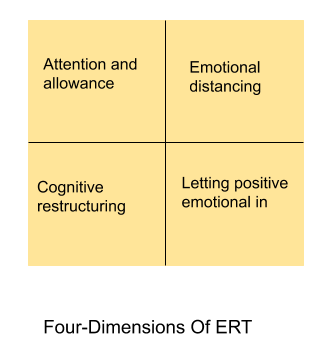
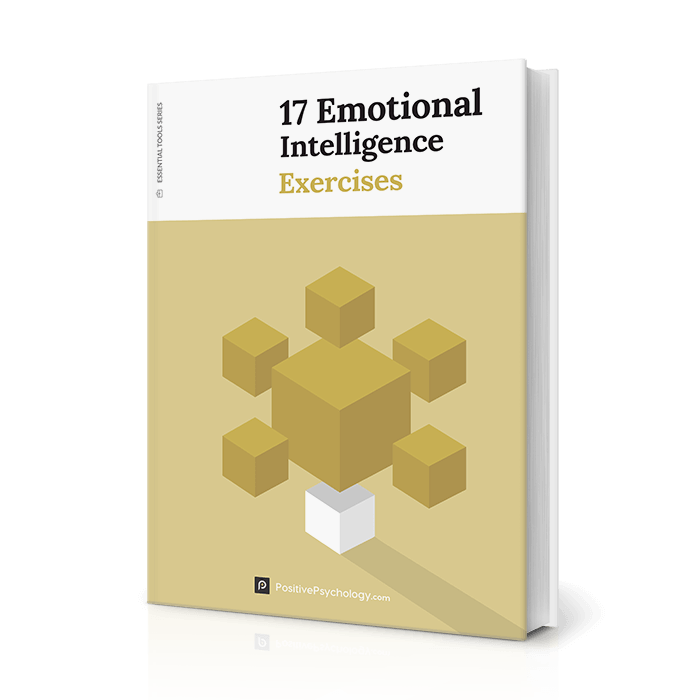
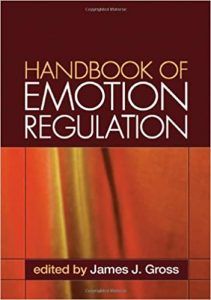
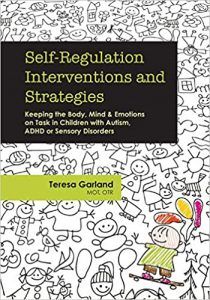
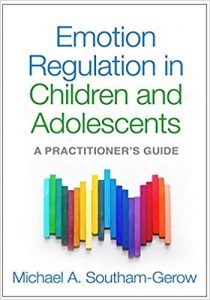
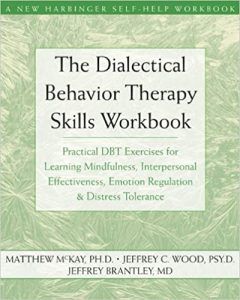



What our readers think
Hi there! Of all the articles I reviewed on this topic for our Workplace Well Being project, this was my favourite. Would it be possible to receive a PDF of the article to print and post on our Well Being Board? Thanks for your consideration 🙂
Thank you for this article, I really liked it.
Just one note if I may. When you state: “Emotion Regulation Therapy is a person-centered approach to dealing with affective regulation. It uses parts of CBT, DBT, Mindfulness, and other humanitarian approaches to achieve the following goals: […]”I believe you ment “other HUMANISTIC approaches”, not humanitarian. Quite different indeed 😉
All the Best
Giada Mignolli
Hi Giada,
Thank you for bringing this correction to our attention!
Kind regards,
-Caroline | Community Manager
very nice informative blog given by you . it is very usefull for me thank you
This was a highly informative article which managed to be comprehensive without being overwhelming. It offered specific techniques and paths to emotional regulation and even included a little neuroscience. I loved the worksheets and ordered the recommended DBT Workbook. I’m inspired and looking forward to improving my ability to better regulate my emotions. Thank you for such a wonderful article.
Thank you so much. Your article is very useful.
thanks for sharing valuable content